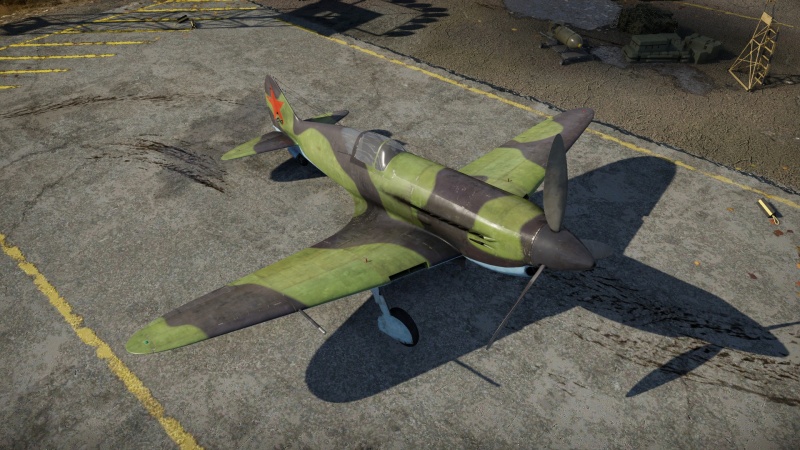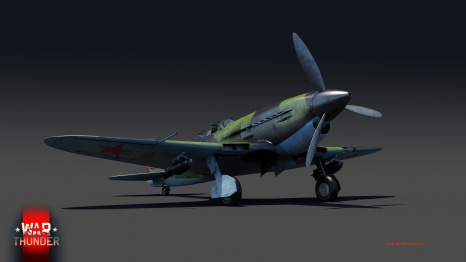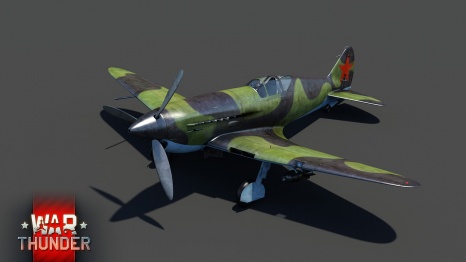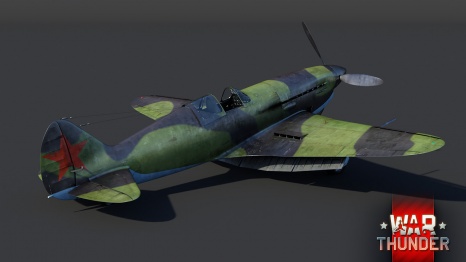Difference between revisions of "ITP (M-1)"
Colok76286 (talk | contribs) (Edits) |
Knirhim@psn (talk | contribs) (→Usage in battles: Added a personal observations about it's performance: will keep playing to fully make denote which planes threaten it the most) |
||
| Line 104: | Line 104: | ||
== Usage in battles == | == Usage in battles == | ||
<!-- ''Describe the tactics of playing in the aircraft, the features of using aircraft in a team and advice on tactics. Refrain from creating a "guide" - do not impose a single point of view, but instead, give the reader food for thought. Examine the most dangerous enemies and give recommendations on fighting them. If necessary, note the specifics of the game in different modes (AB, RB, SB).'' --> | <!-- ''Describe the tactics of playing in the aircraft, the features of using aircraft in a team and advice on tactics. Refrain from creating a "guide" - do not impose a single point of view, but instead, give the reader food for thought. Examine the most dangerous enemies and give recommendations on fighting them. If necessary, note the specifics of the game in different modes (AB, RB, SB).'' --> | ||
| − | + | The ITP-M1 is capable of fulfilling all sorts of roles within the battlefield; thanks to its nose-mounted armament, any shots landed onto any enemy plane will, most of the time, cripple it, if not outright destroying it, while also leaving a lot of room for ground attack. However, the ITP shines against quickly disposing of enemy threats: especially other fighters, relying on a very Boom & Run approach in engagements. However, its 37mm SH-37 cannon is what makes it so deadly: without ammo, the ITP quickly loses its upper hand, but still can deal a blow against enemy aircraft. | |
| + | Trigger discipline heavily rewards the ITP, spraying should only be done when in doubt or necessity, as it only counts with 50 37mm rounds and 400 rounds between the two 20mm cannons; only one HEI-T round has to land on the enemy plane to cause significant damage, mostly instant fire or even ripping off a wing/the tail. While the Default ammunition belt is armed with both HEI-T (High-explosive Incendiary Tracer, Self Destroying- meant for air targets) and API-T (Armor Piercing Incendiary Tracer- meant for ground, armored targets), one can instead choose to focus on one playstyle by changing belts for the cannon: one being composed entirely of HEI-T (meaning that the ITP loses most of its capability to destroy "hard" targets, such as Medium and Light tanks, without taking any ordnance)and the other being composed entirely of API-T, meaning that shots landed on aircraft will not include the firepower of the high-explosive round. | ||
| + | Still, a burst of its armament will deal significant damage, as the 37mm is coupled with two 20mm ShVAK cannons, nose-mounted as well: While it performs best within ranges of around 1km towards a target, the fact its armaments are all nose-mounted means all of the burst's mass will be heavily concentrated. If needed be, taking the Default belt will always be the best choice; leaving room for utilizing the cannon for any target, and as such, being able to fill a multirole approach to the battlefield. | ||
| + | |||
| + | The ITP is not a frontline fighter: rather, its role would be best described as an opportunist attacker, by taking head ons with enemy fighters that are still on a climb, or by swooping in and destroying any distracted enemies, then quickly getting away. Use of WEP should, just as its ammunition management, be limited towards maintaining speed after pulling out of a dive or a quick boost, as continuous use will quickly overheat the engine. It is best to avoid turn-fighting unless the enemy is completely alone, as the aircraft loses a considerable amount of speed in any sort of vertical maneuvers, however it can turn the tide against turn-fighters: but caution is still advised, as many will try and turn-fight with the ITP only as a distraction while backup arrives. Rather than staying in a turn-fight, the ITP can quickly get away from dedicated turn-fighting aircraft such as the Japanese [[Ki-43-III otsu]], a common enemy in its Battle Rating, then circle back when enough distance has been made to try and force a head on attack. | ||
| + | |||
| + | When focusing entirely on a ground attack role, the ITP performs best as a dive-attacker, rather than a low-flying approach, as altitude and speed are the ITP's lifeblood against enemy fighters. | ||
=== Manual Engine Control === | === Manual Engine Control === | ||
{| class="wikitable" style="text-align:center" | {| class="wikitable" style="text-align:center" | ||
| Line 128: | Line 134: | ||
'''Pros:''' | '''Pros:''' | ||
| − | * Powerful armament, can destroy even the most armoured air targets with just a small burst | + | * Powerful armament, can destroy even the most armoured air targets with just a small burst. |
| − | * Quite manoeuvrable | + | * Quite manoeuvrable. |
| − | * As a premium aircraft, has better SL and RP multipliers | + | * As a premium aircraft, has better SL and RP multipliers. |
* ShVAKS have a high rate of fire | * ShVAKS have a high rate of fire | ||
| − | * 37 mm cannon has a rather generous amount of ammo (50 rounds) | + | * 37 mm cannon has a rather generous amount of ammo (50 rounds). |
| − | * 37 mm cannon can load Armored targets belts, capable of penetrating up to 60 mm of armour | + | * 37 mm cannon can load Armored targets belts, capable of penetrating up to 60 mm of armour. |
| − | * In addition to the 37 mm cannon, can carry bombs and rockets, allowing to to be useful in ground battles | + | * In addition to the 37 mm cannon, can carry bombs and rockets, allowing to to be useful in ground battles.. |
| − | * Minimum fuel load is 30 minutes | + | * Minimum fuel load is 30 minutes. |
| − | * Great climb rate, can manage 30 degrees with WEP | + | * Great climb rate, can manage 30 degrees with WEP. |
| − | * From a distance, can be mistaken for a MiG-3, allowing you to take the upper hand | + | * From a distance, can be mistaken for a MiG-3, allowing you to take the upper hand. |
'''Cons:''' | '''Cons:''' | ||
| − | * Liquid cooling system is located in the wings, allowing it to easily be hit | + | * Liquid cooling system is located in the wings, allowing it to easily be hit. |
| − | * Only one 13 mm steel plate protecting the pilot, can easily be pilot sniped | + | * Only one 13 mm steel plate protecting the pilot, can easily be pilot sniped. |
| − | * Forward acceleration isn't very good compared to other aircraft of a similar BR | + | * Forward acceleration isn't very good compared to other aircraft of a similar BR. |
| − | * Engine overheats at 100% throttle | + | * Engine overheats at 100% throttle. |
| − | * 37 mm cannon is inaccurate, making it hard to use | + | * 37 mm cannon is inaccurate, making it hard to use. |
| − | * 37 mm cannon overheats after just 6 shots | + | * 37 mm cannon overheats after just 6 shots. |
| − | * Repair cost is noticeably high in RB/SB | + | * Repair cost is noticeably high in RB/SB. |
== History == | == History == | ||
| Line 182: | Line 188: | ||
* ''topic on the official game forum;'' | * ''topic on the official game forum;'' | ||
* ''other literature.'' --> | * ''other literature.'' --> | ||
| − | + | [[wt:en/news/7061-development-battle-pass-vehicles-itp-m-1-en|[Devblog] ITP (M-1)]] | |
| − | |||
| − | |||
| − | |||
{{AirManufacturer Polikarpov}} | {{AirManufacturer Polikarpov}} | ||
{{USSR fighters}} | {{USSR fighters}} | ||
{{USSR premium aircraft}} | {{USSR premium aircraft}} | ||
Revision as of 18:17, 11 April 2021
Contents
Description
The ITP (M-1) is a premium gift rank III Soviet fighter with a battle rating of 4.7 (AB), 4.0 (RB), and 3.3 (SB). It was introduced during Update "Hot Tracks" as a reward for Battle Pass: Season II, "Steel Centurion".
General info
Flight performance
| Characteristics | Max Speed (km/h at 6,100 m) |
Max altitude (metres) |
Turn time (seconds) |
Rate of climb (metres/second) |
Take-off run (metres) | |||
|---|---|---|---|---|---|---|---|---|
| AB | RB | AB | RB | AB | RB | |||
| Stock | 658 | 639 | 11750 | 21.9 | 22.6 | 12.6 | 12.4 | 395 |
| Upgraded | 695 | 676 | 20.2 | 21.0 | 17.8 | 15.1 | ||
Details
| Features | ||||
|---|---|---|---|---|
| Combat flaps | Take-off flaps | Landing flaps | Air brakes | Arrestor gear |
| ✓ | ✓ | ✓ | X | X |
| Limits | ||||||
|---|---|---|---|---|---|---|
| Wings (km/h) | Gear (km/h) | Flaps (km/h) | Max Static G | |||
| Combat | Take-off | Landing | + | - | ||
| 800 | 320 | 365 | 345 | 260 | ~13 | ~6 |
| Optimal velocities (km/h) | |||
|---|---|---|---|
| Ailerons | Rudder | Elevators | Radiator |
| < 320 | < 250 | < 500 | > 320 |
Survivability and armour
- 13 mm steel seat
- Self-sealing fuel tanks (1 under pilot, 1 under 37 mm cannon breech, 1 in each wing)
Modifications and economy
Armaments
Offensive armament
The ITP (M-1) is armed with:
- 1 x 37 mm SH-37 cannon, nose-mounted (50 rpg)
- 2 x 20 mm ShVAK cannons, nose-mounted (200 rpg = 400 total)
Suspended armament
The ITP (M-1) can be outfitted with the following ordnance:
- Without load
- 2 x 100 kg FAB-100sv bombs (200 kg total)
- 4 x 50 kg FAB-50sv bombs (200 kg total)
- 8 x RS-82 rockets
- 8 x RBS-82 rockets
Usage in battles
The ITP-M1 is capable of fulfilling all sorts of roles within the battlefield; thanks to its nose-mounted armament, any shots landed onto any enemy plane will, most of the time, cripple it, if not outright destroying it, while also leaving a lot of room for ground attack. However, the ITP shines against quickly disposing of enemy threats: especially other fighters, relying on a very Boom & Run approach in engagements. However, its 37mm SH-37 cannon is what makes it so deadly: without ammo, the ITP quickly loses its upper hand, but still can deal a blow against enemy aircraft.
Trigger discipline heavily rewards the ITP, spraying should only be done when in doubt or necessity, as it only counts with 50 37mm rounds and 400 rounds between the two 20mm cannons; only one HEI-T round has to land on the enemy plane to cause significant damage, mostly instant fire or even ripping off a wing/the tail. While the Default ammunition belt is armed with both HEI-T (High-explosive Incendiary Tracer, Self Destroying- meant for air targets) and API-T (Armor Piercing Incendiary Tracer- meant for ground, armored targets), one can instead choose to focus on one playstyle by changing belts for the cannon: one being composed entirely of HEI-T (meaning that the ITP loses most of its capability to destroy "hard" targets, such as Medium and Light tanks, without taking any ordnance)and the other being composed entirely of API-T, meaning that shots landed on aircraft will not include the firepower of the high-explosive round. Still, a burst of its armament will deal significant damage, as the 37mm is coupled with two 20mm ShVAK cannons, nose-mounted as well: While it performs best within ranges of around 1km towards a target, the fact its armaments are all nose-mounted means all of the burst's mass will be heavily concentrated. If needed be, taking the Default belt will always be the best choice; leaving room for utilizing the cannon for any target, and as such, being able to fill a multirole approach to the battlefield.
The ITP is not a frontline fighter: rather, its role would be best described as an opportunist attacker, by taking head ons with enemy fighters that are still on a climb, or by swooping in and destroying any distracted enemies, then quickly getting away. Use of WEP should, just as its ammunition management, be limited towards maintaining speed after pulling out of a dive or a quick boost, as continuous use will quickly overheat the engine. It is best to avoid turn-fighting unless the enemy is completely alone, as the aircraft loses a considerable amount of speed in any sort of vertical maneuvers, however it can turn the tide against turn-fighters: but caution is still advised, as many will try and turn-fight with the ITP only as a distraction while backup arrives. Rather than staying in a turn-fight, the ITP can quickly get away from dedicated turn-fighting aircraft such as the Japanese Ki-43-III otsu, a common enemy in its Battle Rating, then circle back when enough distance has been made to try and force a head on attack.
When focusing entirely on a ground attack role, the ITP performs best as a dive-attacker, rather than a low-flying approach, as altitude and speed are the ITP's lifeblood against enemy fighters.
Manual Engine Control
| MEC elements | ||||||
|---|---|---|---|---|---|---|
| Mixer | Pitch | Radiator | Supercharger | Turbocharger | ||
| Oil | Water | Type | ||||
| Controllable | Controllable Not auto controlled |
Controllable Not auto controlled |
Controllable Not auto controlled |
Separate | Not controllable 1 gear |
Not controllable |
Pros and cons
Pros:
- Powerful armament, can destroy even the most armoured air targets with just a small burst.
- Quite manoeuvrable.
- As a premium aircraft, has better SL and RP multipliers.
- ShVAKS have a high rate of fire
- 37 mm cannon has a rather generous amount of ammo (50 rounds).
- 37 mm cannon can load Armored targets belts, capable of penetrating up to 60 mm of armour.
- In addition to the 37 mm cannon, can carry bombs and rockets, allowing to to be useful in ground battles..
- Minimum fuel load is 30 minutes.
- Great climb rate, can manage 30 degrees with WEP.
- From a distance, can be mistaken for a MiG-3, allowing you to take the upper hand.
Cons:
- Liquid cooling system is located in the wings, allowing it to easily be hit.
- Only one 13 mm steel plate protecting the pilot, can easily be pilot sniped.
- Forward acceleration isn't very good compared to other aircraft of a similar BR.
- Engine overheats at 100% throttle.
- 37 mm cannon is inaccurate, making it hard to use.
- 37 mm cannon overheats after just 6 shots.
- Repair cost is noticeably high in RB/SB.
History
Devblog
At the end of 1940, the aircraft designer Nikolai Polikarpov came up with the initiative to create a fundamentally new combat aircraft for Soviet aviation - a fighter with heavy cannon armament, that could fulfill tasks typical for heavy fighters and attack aircraft, while possessing the flight characteristics of a light single-engine monoplane fighter. The military accepted Polikarpov's idea with interest, formulating tasks for the future aircraft, such as effective air combat, including the destruction of bombers, aerial destruction of tanks and armored vehicles, as well as escort missions. The assembly of the first prototype began in May of 1941, however, due to the rapid offensive from the enemy towards Moscow, production had to be evacuated to Novosibirsk, Siberia, where the test unit was completed.
ITP (M-1) (ITP is for “heavy cannon fighter”) was a monoplane fighter with a 1,650 hp M-107P engine, the armament of the aircraft consisted of a 37mm Sh-37 motor-mounted gun and a pair of 20mm ShVAK cannons. Flight tests began in February 1942, but were not fully completed due to engine problems. A little later, versions with the M-107A and the AM-37 engines were tested, on the second prototype, the 37mm cannon was replaced with another ShVAK cannon. Work on the ITP project was interrupted due to the untimely death of the Soviet "king of fighters" in 1944.
Media
- Images
- Videos
See also
Links to the articles on the War Thunder Wiki that you think will be useful for the reader, for example:
- reference to the series of the aircraft;
- links to approximate analogues of other nations and research trees.
External links
| Polikarpov Design Bureau (Опытное конструкторское бюро Поликарпова) | |
|---|---|
| I-15 | I-15 WR · I-15 M-22 · I-15 M-25 · I-15bis · Krasnolutsky's I-15bis |
| I-153 | I-153 M-62 · Zhukovsky's I-153-M62 · I-153P |
| I-16 | I-16 type 5 · I-16 type 10 · I-16 type 18 · I-16 type 24 · I-16 type 27 · I-16 type 28 |
| I-180 | I-180S · I-185 (M-71) · I-185 (M-82) |
| ITP | ITP (M-1) |
| Twin-engine fighters | TIS MA |
| Bombers | Po-2 · Po-2M |
| Export | ␗I-15bis · ␗I-153 M-62 · ␗I-16 type 5 · ␗I-16 type 10 · ␗I-16 type 17 · ␗I-16 Chung 28 |
| USSR fighters | |
|---|---|
| I-15 | I-15 WR · I-15 M-22 · I-15 M-25 · I-15bis · Krasnolutsky's I-15bis |
| I-153 M-62 · Zhukovsky's I-153-M62 · I-153P | |
| I-16 | I-16 type 5 · I-16 type 10 · I-16 type 18 · I-16 type 24 · I-16 type 27 · I-16 type 28 · I-180S |
| I-29 | I-29 |
| I-185 | I-185 (M-71) · I-185 (M-82) |
| I-225 | I-225 |
| ITP | ITP (M-1) |
| MiG-3 | MiG-3-15 · MiG-3-15 (BK) · MiG-3-34 |
| LaGG | I-301 · LaGG-3-4 · LaGG-3-8 · LaGG-3-11 · LaGG-3-23 · LaGG-3-34 · LaGG-3-35 · LaGG-3-66 |
| La | La-5 · La-5F · La-5FN · La-7 · Dolgushin's La-7 · La-7B-20 · La-9 · La-11 |
| Yak-1/7 | Yak-1 · Yak-1B · Yak-7B |
| Yak-3 | Yak-3 · Yak-3P · Yak-3T · Yak-3U · Yak-3 (VK-107) |
| Yak-9 | Yak-9 · Yak-9B · Golovachev's Yak-9M · Yak-9T · Yak-9K · Yak-9U · Yak-9UT · Yak-9P |
| Other countries | ▂P-40E-1 · ▂P-47D-27 · ▂Hurricane Mk IIB · ▂Fw 190 D-9 · ▂Spitfire Mk IXc |
| P-39 | ▂P-39K-1 · ▂Pokryshkin's P-39N-0 · ▂P-39Q-15 |
| P-63 | ▂P-63A-5 · ▂P-63A-10 · ▂P-63C-5 |
| USSR premium aircraft | |
|---|---|
| Fighters | Krasnolutsky's I-15bis · I-16 type 28 · Zhukovsky's I-153-M62 · I-153P · I-180S · I-301 · ITP (M-1) |
| LaGG-3-4 · LaGG-3-23 · LaGG-3-34 · Dolgushin's La-7 · La-11 | |
| Yak-3 (VK-107) · Yak-3T · Golovachev's Yak-9M | |
| ▂P-39K-1 · ▂Pokryshkin's P-39N-0 · ▂P-39Q-15 · ▂P-40E-1 · ▂P-47D-27 · ▂P-63A-5 · ▂P-63A-10 · ▂P-63C-5 | |
| ▂Hurricane Mk IIB · ▂Spitfire Mk IXc · ▂Fw 190 D-9 | |
| Twin-engine fighters | I-29 |
| Jet fighters | Su-11 · MiG-15bis ISH · MiG-17AS · MiG-21S (R-13-300) · MiG-23ML |
| Strike aircraft | IL-2M "Avenger" · IL-2 M-82 · IL-8 (1944) · Su-6 · Tandem MAI · TIS MA · Su-8 · Tu-1 |
| Yak-38 · Su-7BMK · Su-25K · Su-39 | |
| Bombers | Po-2M · Be-6 · MBR-2-M-34 · Pe-2-205 · TB-3M-17-32 |
| ▂PBY-5A Catalina · ▂Hampden TB Mk I · ▂A-20G-30 · ▂B-25J-30 | |








